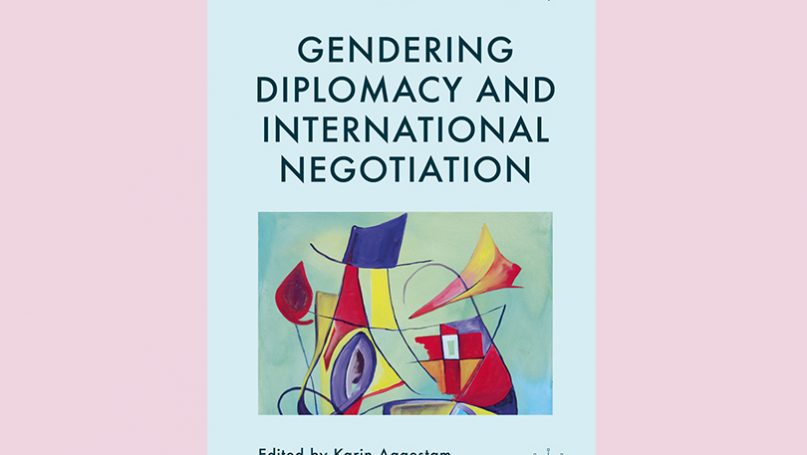
Gendering Diplomacy and International Negotiation
Edited by Karin Aggestam and Ann E. Towns
Palgrave Macmillan, 2018
Throughout history, women have played significant roles and provided critical guidance in diplomacy, both formally and informally, as well as through peace efforts. The analysis of women and men, their language, and behavior, through the scholarly lens of gender in those same crucial situations, however, is relatively new. Karin Aggestam and Ann E. Towns, both political scientists at universities in Sweden, provide a thorough and deeply analytical examination of women and issues of gender in international relations in this impressive work. Casting a net widely to include a broad geographic spectrum of nations—from Sweden to Japan, Israel to Brazil—the chapters within present a wealth of data exploring the numbers, rank, and achievements of women within international affairs. But it is the unrelenting message of the seventeen authors of these chapters that collectively demand the uncomfortable truth be fully addressed. Equality and equity have not been achieved simply because women are involved in diplomatic relations and peace negotiations. Sitting in the room matters little if a woman is not at the table. A seat at the table is not enough if a woman’s perspective and words are dismissed as irrelevant when compared to chief priorities such as politics, military, or economic concerns. In short, this excellent series of chapters demonstrate beyond a shadow of a doubt that counting the increasing number of women in foreign relations does not mean that women actually count in foreign relations.
In approaching this problematic state of affairs, as it were, Aggestam and Towns separate their exhaustive dialogue into two individual, but interrelated, categories. Part one focuses on gender within the foreign service from a global perspective. The six chapters within consider why there has been a steadily increasing number of women in diplomatic circles in recent decades but so few women at the upper echelons of diplomatic decision making. A fictional county can hardly pride themselves on the hypothetical example of having 50% women in their foreign service based on employing some 100 male ambassadors, in positions of high status, and 100 female typists, in positions of low status. Few would argue that such a numerical breakdown is an example of progressive parity in the workplace. Data informed research from Foggy Bottom to Turkey examine every possible position within the Ministries of Foreign Affairs (MFA) from around the world and question whether women being posted at certain levels are merely token appointments in locations of lesser clout or actual triumphs of professional achievement; hence, a level of “relational and gendered division of labour” remains based on women rarely being appointed to ambassadorial positions with significant economic and military status (p. 3). Clearly, there are hierarchies of prestige, influence, and power among positions within international circles. More than one author notes the lack of women in ambassadorial positions within the so-called “Elizabeth Arden Circuit,” which includes highly prized assignments characterized by “interesting activities, high-visibility tasks and good networking opportunities” in places such as “Buenos Aires, Washington, Rome, Paris, London, Berlin, Lisbon, Tokyo, and Vatican City” (p. 115).
Part two of Aggestam and Towns’s book concentrates on aspects of gender within international negotiation. If the lack of women at high levels in the foreign service and arguable tokenism presented in part one was disappointing, the almost complete absence and dismissal of women in peace mediations and related negotiations on a global level is utterly distressing. Similar to recurring themes in part one, several authors discuss the fact that efforts at securing an effective and lasting peace are far more likely when women are, in fact, at the table and their priorities and goals are taken seriously and prioritized. Likewise, multiple chapters mention the fact that female peace mediators most often come from African, Nordic, and American countries. But the authors make clear that the presence of women in peace efforts is not enough. Nothing short of explicit inclusions of “gender equality provisions” will suffice (p. 179). As long as women are not allowed to lead from the front on such issues, peace and diplomacy will be difficult to attain and increasingly difficult to maintain.
Clearly, this collection reveals that a “glass ceiling” exists for women “in advancing to senior diplomatic positions in general and peacemaking in particular” (p. 157). The depth and breadth of the research shared in this important work is exceptional. The fastidious coordination on behalf of the editors to link the works is to be commended. Almost every chapter references other chapters based on thematic connections. Rarely does an anthology read so smoothly or cohesively between such a myriad of foci. Many of the authors candidly admit that their respective chapter does not answer this question or offer suggestions for that inquiry. But their cooperative work offers all of us an enormous step forward in understanding the current state of affairs in international relations as experienced by the female boots, or heels, on the ground.
Further Reading on E-International Relations
- Review – International Relations, Music and Diplomacy
- Review Feature – New Perspectives on Diplomacy
- Review – Russia’s Public Diplomacy: Evolution and Practice
- Review – Race, Gender, and Culture in International Relations
- Open Access Book – Meditations on Diplomacy: Comparative Cases in Diplomatic Practice and Foreign Policy
- Review – Sexual Violence Against Men in Global Politics